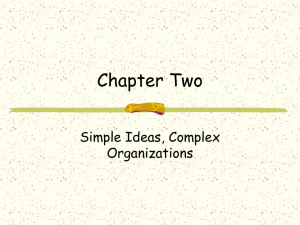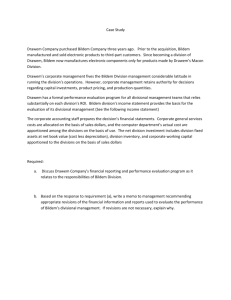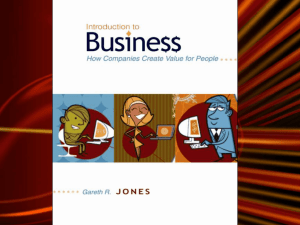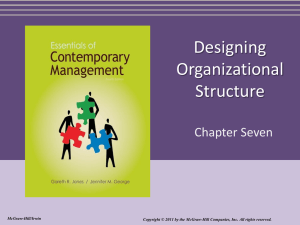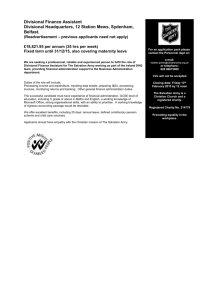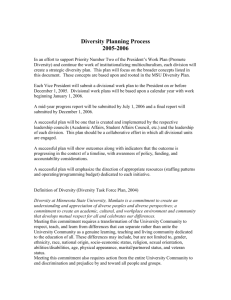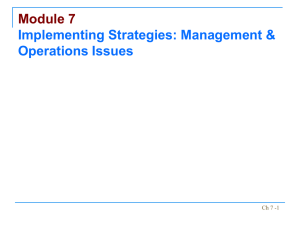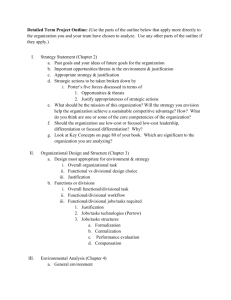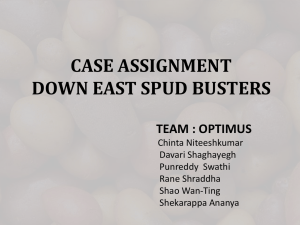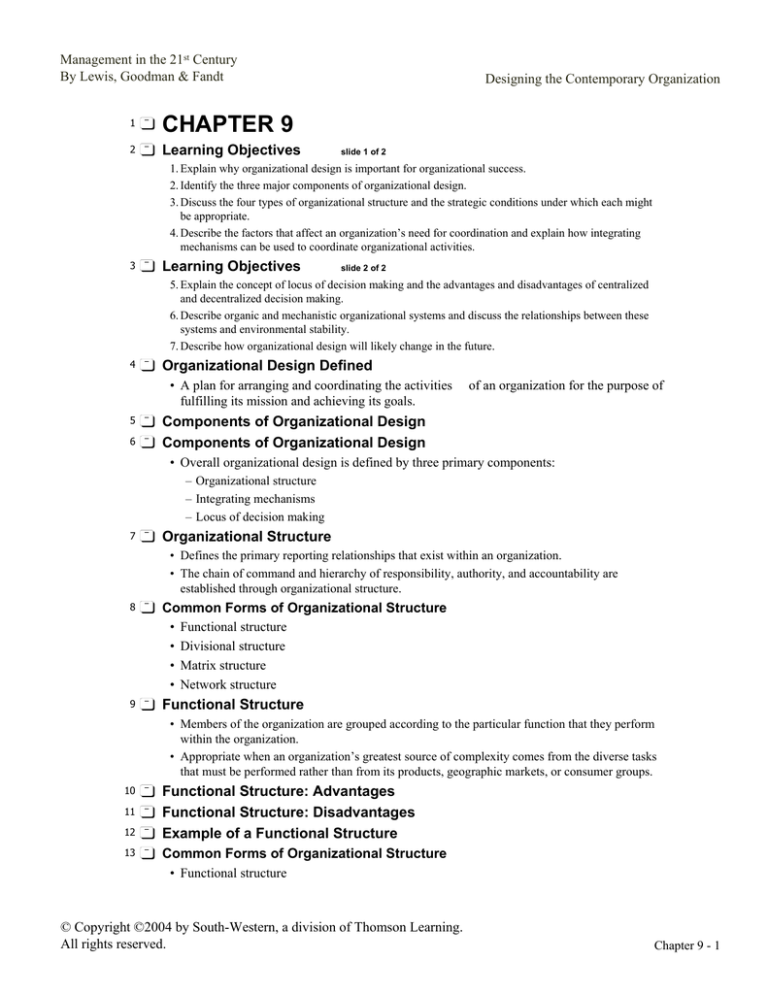
Management in the 21st Century
By Lewis, Goodman & Fandt
1
CHAPTER 9
2
Learning Objectives
Designing the Contemporary Organization
slide 1 of 2
1. Explain why organizational design is important for organizational success.
2. Identify the three major components of organizational design.
3. Discuss the four types of organizational structure and the strategic conditions under which each might
be appropriate.
4. Describe the factors that affect an organization’s need for coordination and explain how integrating
mechanisms can be used to coordinate organizational activities.
3
Learning Objectives
slide 2 of 2
5. Explain the concept of locus of decision making and the advantages and disadvantages of centralized
and decentralized decision making.
6. Describe organic and mechanistic organizational systems and discuss the relationships between these
systems and environmental stability.
7. Describe how organizational design will likely change in the future.
4
Organizational Design Defined
• A plan for arranging and coordinating the activities
fulfilling its mission and achieving its goals.
5
6
of an organization for the purpose of
Components of Organizational Design
Components of Organizational Design
• Overall organizational design is defined by three primary components:
– Organizational structure
– Integrating mechanisms
– Locus of decision making
7
Organizational Structure
• Defines the primary reporting relationships that exist within an organization.
• The chain of command and hierarchy of responsibility, authority, and accountability are
established through organizational structure.
8
Common Forms of Organizational Structure
• Functional structure
• Divisional structure
• Matrix structure
• Network structure
9
Functional Structure
• Members of the organization are grouped according to the particular function that they perform
within the organization.
• Appropriate when an organization’s greatest source of complexity comes from the diverse tasks
that must be performed rather than from its products, geographic markets, or consumer groups.
10
11
12
13
Functional Structure: Advantages
Functional Structure: Disadvantages
Example of a Functional Structure
Common Forms of Organizational Structure
• Functional structure
© Copyright ©2004 by South-Western, a division of Thomson Learning.
All rights reserved.
Chapter 9 - 1
Management in the 21st Century
By Lewis, Goodman & Fandt
Designing the Contemporary Organization
• Divisional structure
• Matrix structure
• Network structure
14
Divisional Structure
• Members of the organization are grouped on the basis of:
– Common products
– Geographic markets
– Customers served
15
Types of Divisional Structure
• Product divisional
– Most appropriate for organizations with relatively diverse product lines that require specialized efforts to achieve
high product quality.
• Geographic divisional
– Most appropriate for organizations with limited product lines that either have wide geographic coverage or desire to
grow through geographic expansion.
• Customer divisional
– Most appropriate for organizations that have separate customer groups with very specific and distinct needs.
16
Product Divisional
• Advantages
– Enhanced coordination.
– Better assessment of manager performance and responsibility.
– Development of generalist managers.
• Disadvantages
– Managers may lack expertise to operate in wide geographic areas.
– Duplication of resources.
17
18
Product Divisional Structure
Geographic Divisional
• Advantages
– Allows for focus on specific
– Good structure for growth
– Adaptable to local needs.
new markets.
along geographic lines.
• Disadvantages
– Duplication of product or product/technology efforts.
– Coordination and integration are difficult.
– May be difficult to manage diverse product lines.
19
Geographic Divisional Structure
20
Common Forms of Organizational Structure
• Functional structure
• Divisional structure
• Matrix structure
• Network structure
21
Matrix Structure
• A structure in which the tasks of the organization are grouped along two organizational
dimensions simultaneously.
© Copyright ©2004 by South-Western, a division of Thomson Learning.
All rights reserved.
Chapter 9 - 2
Management in the 21st Century
By Lewis, Goodman & Fandt
Designing the Contemporary Organization
• Examples include:
– Product/function
– Product/geographic region
22
23
24
Matrix Structure: Advantages
Matrix Structure: Disadvantages
A Multinational
Matrix
Structure
25
Common Forms of Organizational Structure
• Functional structure
• Divisional structure
• Matrix structure
• Network structure
26
Network Structure
• A contemporary organizational structure that is founded on a set of alliances with other
organizations that serve a wide variety of functions.
27
Types of Network Structure
• Internal network
– A network structure that relies on internally developed units to provide services to a core organizational unit.
• Stable network
– A network structure that utilizes external alliances selectively as a mechanism for gaining strategic flexibility.
• Dynamic network
– A network structure that makes extensive use of outsourcing through alliances with outside organizations.
28
29
30
31
Network Structure: Advantages
Network Structure: Disadvantages
Sample Network
Structure
Components of Organizational Design
• Overall organizational design is defined by three primary components:
– Organizational structure
– Integrating mechanisms
– Locus of decision making
32
Managing Complexity Through Integration
• Interdependence is the degree to which work groups are interrelated.
• Three primary levels of work group integration:
– Pooled interdependence
– Sequential interdependence
– Reciprocal interdependence
33
Pooled Interdependence
• Occurs when organizational units have a common resource but no interrelationship with
one another.
© Copyright ©2004 by South-Western, a division of Thomson Learning.
All rights reserved.
Chapter 9 - 3
Management in the 21st Century
By Lewis, Goodman & Fandt
34
Designing the Contemporary Organization
Sequential Interdependence
• Occurs when organizational units must coordinate the flow of information, resources, and
tasks from one unit to another.
35
Reciprocal Interdependence
• Occurs when information, resources, and tasks must be passed back and forth between
work groups.
36
Integrating Mechanisms
• Methods for managing the flow of information, resources, and tasks within the organization.
• Three major categories of integrating mechanisms are:
– General management systems.
– Methods of increasing coordination potential.
– Methods of reducing the need for coordination.
37
General Management Systems
• Some coordination of work units may be achieved through the development of general
management systems such as:
– The managerial hierarchy
– Rules and procedures
– Plans and goals
• Such mechanisms form the foundation of an organization’s integration system.
38
Increasing Coordination Potential
• Two popular mechanisms for increasing coordination potential both vertically and horizontally in the
organization are information systems and lateral relationships.
– Information systems facilitate the flow of information up and down the traditional chain of command
and across organizational units.
– Lateral relationships exist across work units and serve as mechanisms for exchanging decisionmaking information.
39
Boundary Spanning Coordination
• Lateral relationships that help to integrate and coordinate the activities of the organization.
• Examples include:
–
–
–
–
–
40
Liaisons
Committees
Task forces
Integrating positions
Interfunctional work teams
Reducing the Need for Coordination
• In essence, the organization creates “slack resources” that reduce the interdependence of
the work groups.
• As a result, the need for integrating mechanisms is reduced.
41
Components of Organizational Design
• Overall organizational design is defined by three primary components:
– Organizational structure
– Integrating mechanisms
– Locus of decision making
42
Locus of Decision Making
© Copyright ©2004 by South-Western, a division of Thomson Learning.
All rights reserved.
Chapter 9 - 4
Management in the 21st Century
By Lewis, Goodman & Fandt
Designing the Contemporary Organization
• Locus of decision making refers to the degree to which decision making is centralized
versus decentralized.
43
Centralized Decision Making
• Advantage
– Gives top-level management maximum control.
• Disadvantage
– Limits the organization’s ability to respond quickly and effectively to changes in the environment.
44
Decentralized Decision Making
• Advantage
– Organizations can respond to environmental change more rapidly and effectively because the
decision makers are the people closest to the situation.
• Disadvantage
– Top-level managers lose some control.
45
Mechanistic Vs. Organic Systems
• Mechanistic Systems
– Highly centralized organizations in which decision-making authority rests with top-level
management.
• Organic Systems
– Decentralized organizations that push decision making to the lowest levels of the organization in an
effort to respond more effectively to environmental change.
46
The Impact of Environmental Stability
• Stable Environments
– Environments that experience little change.
• Turbulent Environments
– Environments that are characterized by rapid and significant change.
47
Organizational Design
for a Changing Environment
• Adaptive Organization
– An organization that eliminates bureaucracy which limits employee creativity and brings the
decision makers of the organization closer to the customer.
48
Implications for Leaders:
Organizational Design
slide 1 of 2
• Remember that organizational design provides an important mechanism for achieving the strategic and
operational goals of the organization.
• Structure their organizations to cope with their source of greatest complexity.
• Consider ways that partnerships between members of the organization, as well as alliances with
other organizations, can create synergy and improve organizational performance.
• Utilize advanced information technology to support dispersed operations, people, and partners.
49
Implications for Leaders:
Organizational Design
slide 2 of 2
• Look for ways to increase the integration potential of the organization or to reduce the need for
integration.
• Evaluate the advantages and disadvantages associated with centralized versus decentralized decision
making, given the specific circumstances of the organization.
• Strive to develop an adaptive and flexible organization that is effective in a dynamic business
© Copyright ©2004 by South-Western, a division of Thomson Learning.
All rights reserved.
Chapter 9 - 5
Management in the 21st Century
By Lewis, Goodman & Fandt
Designing the Contemporary Organization
environment.
© Copyright ©2004 by South-Western, a division of Thomson Learning.
All rights reserved.
Chapter 9 - 6

